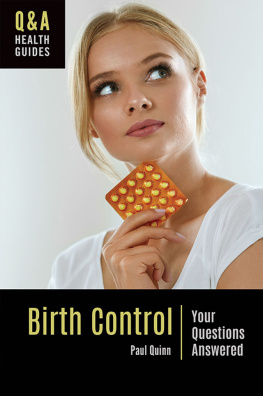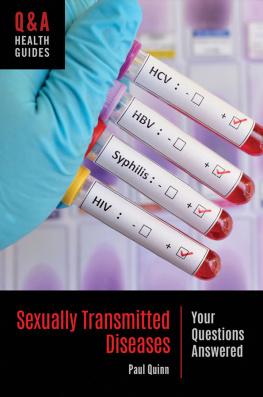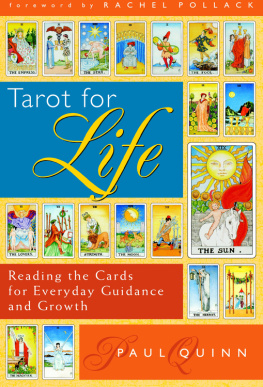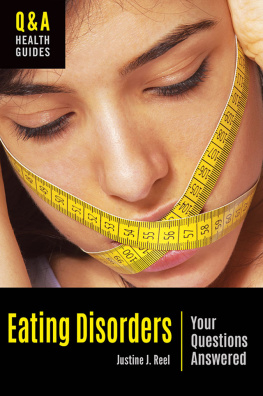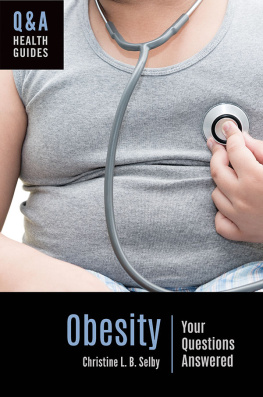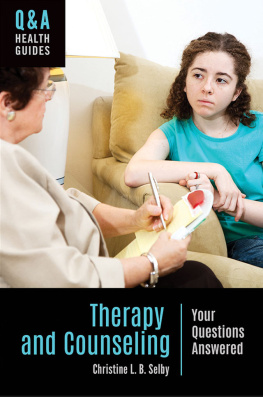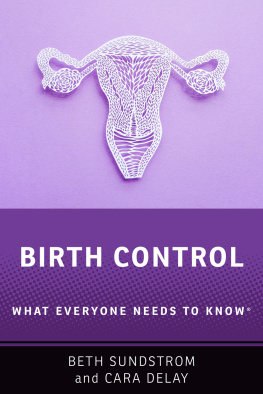Birth Control
Recent Titles in
Q&A Health Guides
Self-Injury: Your Questions Answered
Romeo Vitelli
Living Green: Your Questions Answered
Amy Hackney Blackwell
Sexually Transmitted Diseases: Your Questions Answered
Paul Quinn
Mindfulness and Meditation: Your Questions Answered
Blaise Aguirre
Anxiety and Panic Disorders: Your Questions Answered
Daniel Zwillenberg
Substance Abuse: Your Questions Answered
Romeo Vitelli
Eating Disorders: Your Questions Answered
Justine J. Reel
Food Allergies and Sensitivities: Your Questions Answered
Alice C. Richer
Obesity: Your Questions Answered
Christine L. B. Selby
BIRTH CONTROL
Your Questions Answered
Paul Quinn
Q&A Health Guides
Copyright 2019 by ABC-CLIO, LLC
All rights reserved. No part of this publication may be reproduced, stored in a retrieval system, or transmitted, in any form or by any means, electronic, mechanical, photocopying, recording, or otherwise, except for the inclusion of brief quotations in a review, without prior permission in writing from the publisher.
Library of Congress Cataloging-in-Publication Data
Names: Quinn, Paul, 1971 author.
Title: Birth control : your questions answered / Paul Quinn.
Description: Santa Barbara, CA : Greenwood, an imprint of ABC-CLIO, LLC, [2019] | Series: Q&A health guides | Includes bibliographical references and index.
Identifiers: LCCN 2018051691 (print) | LCCN 2018053152 (ebook) | ISBN 9781440862717 (ebook) | ISBN 9781440862700 (print : alk. paper)
Subjects: LCSH: Birth control. | YouthSexual behavior.
Classification: LCC HQ766 (ebook) | LCC HQ766 .Q85 2019 (print) | DDC 613.9dc23
LC record available at https://lccn.loc.gov/2018051691
ISBN: 978-1-4408-6270-0 (print)
978-1-4408-6271-7 (ebook)
23 22 21 20 19 1 2 3 4 5
This book is also available as an eBook.
Greenwood
An Imprint of ABC-CLIO, LLC
ABC-CLIO, LLC
147 Castilian Drive
Santa Barbara, California 93117
www.abc-clio.com
This book is printed on acid-free paper 
Manufactured in the United States of America
This book discusses treatments (including types of medication and mental health therapies), diagnostic tests for various symptoms and mental health disorders, and organizations. The authors have made every effort to present accurate and up-to-date information. However, the information in this book is not intended to recommend or endorse particular treatments or organizations, or substitute for the care or medical advice of a qualified health professional, or used to alter any medical therapy without a medical doctors advice. Specific situations may require specific therapeutic approaches not included in this book. For those reasons, we recommend that readers follow the advice of qualified health care professionals directly involved in their care. Readers who suspect they may have specific medical problems should consult a physician about any suggestions made in this book.
For Mom and David... once again
Contents
All of us have questions about our health. Is this normal? Should I be doing something differently? Whom should I talk to about my concerns? And our modern world is full of answers. Thanks to the Internet, theres a wealth of information at our fingertips, from forums where people can share their personal experiences to Wikipedia articles to the full text of medical studies. But finding the right information can be an intimidating and difficult tasksome sources are written at too high a level, others have been oversimplified, while still others are heavily biased or simply inaccurate.
Q&A Health Guides address the needs of readers who want accurate, concise answers to their health questions, authored by reputable and objective experts, and written in clear and easy-to-understand language. This series focuses on the topics that matter most to young adult readers, including various aspects of physical and emotional well-being as well as other components of a healthy lifestyle. These guides will also serve as a valuable tool for parents, school counselors, and others who may need to answer teens health questions.
All books in the series follow the same format to make finding information quick and easy. Each volume begins with an essay on health literacy and why it is so important when it comes to gathering and evaluating health information. Next, the top five myths and misconceptions that surround the topic are dispelled. The heart of each guide is a collection of questions and answers, organized thematically. A selection of five case studies provides real-world examples to illuminate key concepts. Rounding out each volume are a directory of resources, glossary, and index.
It is our hope that the books in this series will not only provide valuable information but also help guide readers toward a lifetime of healthy decision making.
This work would not be possible without the support and encouragement from my family, friends, and colleagues. Specifically, sincere thanks and appreciation to Eileen Guidice, David Gilsenan, Maggie and Milo, Tina Neri-Badame, Gregory Locoparra, Denise Mojica, Mary Quinn, Kelly Greco, Joe and Gail Guidice, Anthony and Laura Guidice, Roxanne Guidice, Donna Petrolia, John and Mindy Gilsenan, Mike and Mary Lanni, Christine Lanni, Michael Lanni and Alyssa DeJoy, John and Gina Nicoletti-Gilsenan, Kate and Marwan Amaisse, Matt Gilsenan, and the memory of Gladys Gilsenan. In addition, Robert Velez, Maryanne Hedrick, Larry Lane, Joel Kunkel and Chris Vano, Jim McCoy, Sean and Marie Sherrock, Ian Klein, Felipe Guzman, Marvin Kasper, Ann Marie Leichman, Charles Vannoy, Peter Jarosz and my friends, and coworkers and colleagues of The Valley Health System were a constant source of support and encouragement.
I remain extremely grateful to Maxine Taylor, Lettie Conrad, and Tracey Molineaux for their literary, publishing, and promotional expertise and direction.
Some people never get to meet their heroes or guardian angelI was raised with mine. Thank you, Vinny, for the spirit that pushes me to do more and be more than I ever imagined.
Finally, I can do this work only because of the invaluable lessons I have learned from the men and women I have had the honor to care for, my patientsfor over two decades of nursing and midwifery practice. Your lives, stories, resilience, and spirit are forever part of my soul.
Over 50 percent of the pregnancies in the United States are unplanned, with 3 million women becoming pregnant unintentionally each year. However, the use of some form of contraception continues to increase along with the number of men and women who are purposely opting to be sexually active but avoiding the possibility of pregnancy. According to the U.S. Center for Disease Control and Prevention, 62 percent of women in the United States are currently using some form of contraception, demonstrating that the use of birth control, or contraception, is rising. The scientific community and the pharmaceutical industry have addressed the increased need for specialized, safe methods of contraception. However, the number of options for both men and women has become staggering and can often be confusing when attempting to choose which method will best serve an individual or couple.
Education has been highlighted as a key strategy to assist an individual or couple to choose which contraceptive method or option would work best for them. A plethora of information exists on the Internet and in print regarding the various birth control methods. Anyone can search a specific method and review its pros and cons or read other peoples experiences with their use of a specific method. In addition, birth control has become popularized through television commercials or print advertisements in major magazines or newspapers. However, the information contained on specific websites or in commercially available public information can be misleading or biased. Not all the information on the Internet or in print is factual, accurate, or applicable for all men or women. Further, the risks, complications, side effects, or impact on future fertility are often absent or ignored. Birth control, however, is not for everyone. There is also a wide variation among the existing birth control methods. Some methods, for example, purposely require a prescription, while others can be purchased over the counter. Overall, each method of birth control is safe when it is selected and used properly and consistently by an individual.

